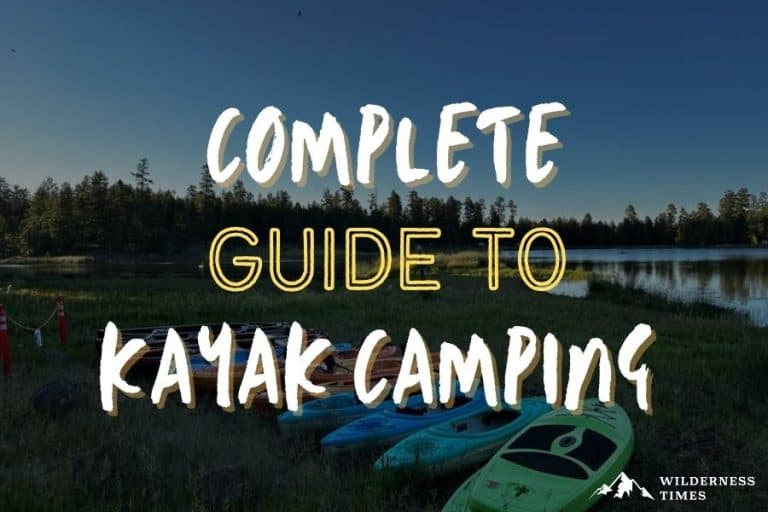Ready to spice up your next camping trip?
It’s time to switch from walking to paddling.
Taking a water route lets you explore nature from a whole new perspective.
Before you take up kayak camping, there are a few things you need to know. But don’t worry, I got you covered.
From choosing a boat to packing your gear, this article will help you prepare for your aquatic adventure.
Let’s get straight to the point!
Table of Contents
TogglePlanning A Kayak Camping Trip
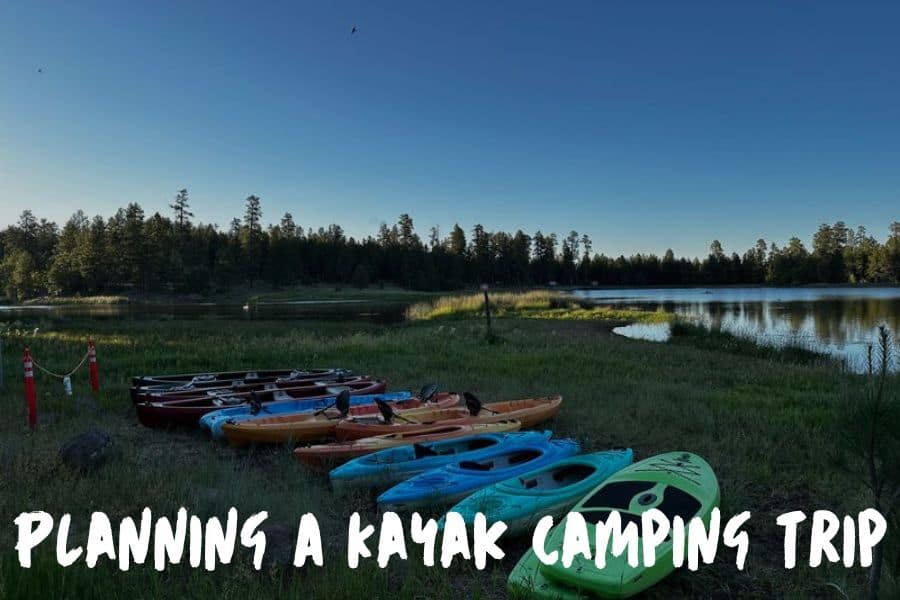
Regardless of where you plan on kayaking, always do your research at home.
If you’re planning a longer trip, plan your campsite for each night in advance. Find suitable locations on the map, and calculate the time it might take you to travel from point A to point B.
But that’s not all that’s important.
You probably won’t get lost paddling around a tiny lake, but if you’re paddling down a river, bring a map. You need to keep a tab on your current location, otherwise, you’ll have a hard time getting back.
Trust me, it only takes a second of carelessness to find yourself lost, without any idea which way you came from.
But with a map or a GPS, you can find your way back a lot easier.
You should also always remember to check the weather forecast. There’s nothing worse than finding out you’re not packed or dressed for the occasion – when it’s too late.
Another thing to keep in mind is that day and night temperatures can differ quite a bit. It might be scorching hot at midday, but once the sun sets, it might start to feel like winter.
Kayak VS Canoe
At first glance, you might say these two boats are similar. But if you look more closely, you’ll realize their design is actually quite different.
Canoes have a wide frame and an open deck. Thanks to their design, they can accommodate multiple passengers while also storing more camping gear like your tent and sleeping bag(s). Plus, you can easily move around the boat.
Kayaks are, usually, closed-deck boats. I say usually because there’s such a thing as a sit-on-top kayak. This type of kayak has an open top design, but there’s practically no space for your gear.
Sit-in kayaks are the more popular type of kayak. They feature a closed top, meaning your legs, along with the rest of the deck, are covered. But since they sit in the water lower than canoes do, this design prevents water from getting in so easily.
Another thing that’s different about these boats is the way you paddle them. In canoes, you either sit on a bench or kneel in the boat, moving it through the water with a one-bladed paddle.
Canoes are generally heavier than kayaks, which makes them more stable, but also more difficult to navigate. And since you’re using a one-bladed paddle, this is easier done in company.
In kayaks, you sit with your legs stretched out, holding a double-ended paddle in the middle, alternating dipping each end into the water.
Since kayaks are generally narrower than canoes, maneuvering the boat shouldn’t be too hard, even for beginners.
Choosing A Kayak/Canoe
Kayak or canoe – which is a better choice?
If you’re camping with family or dogs, all of you can fit in a canoe, along with your camping gear.
But, keep in mind your gear is more likely to get wet on a canoe camping trip. Plus, canoes are more difficult to transport.
Considering that paddling a canoe is more challenging, a kayak camping trip is probably a better option. Especially if you plan on doing it in moving water.
As I mentioned in the section above, there are two types of kayaks – sit-on-top and sit-in. The former is easier to get in and out of, but that’s pretty much where its advantages end.
Since they feature an open design, you’re going to get splashed quite a bit. Unless it’s 100°F outside, no one wants to get that wet.
This type of kayak is also heavier than a sit-in. Plus, there’s practically no storage space!
Sit-ins offer so much – there’s decent storage space, and your lower body is protected not only from water, but wind, too. If you’re paddling faster than Speedy Gonzales runs, things can get pretty windy and cold.
Material
Before I get into all the different types of kayaks there are, let’s talk about different materials for a bit.
Polyethylene
This is the most affordable option.
A kayak made of polyethylene is durable and can take quite a beating.
But, it’s also heavier than other options.
Plus, polyethylene degrades over time with exposure to UV rays.
Thermoform ABS
Polyethylene’s big brother ABS is slightly more expensive, but what it offers is well worth it.
Durability is what these two types of plastic have in common, but ABS also weighs a little bit less.
What’s more, it has a much better UV resistance.
Composites
This type of kayak is made of either fiberglass, aramid, carbon fiber, or a blend of these fabrics.
They’re lightweight, fast and easily maneuvered. You’ll glide with ease even through the roughest waters.
Premium products come at a premium price though. You can expect to pay a pretty penny for this supersonic boat.
But despite costing more, they’re actually more fragile than the other two options.
Inflatable
No, I don’t mean using a pool float as a kayak replacement. Inflatable technology has come a very long way since we were kids.
An inflatable kayak is durable, stable, and a breeze to transport. Once you’re done paddling, just deflate it and place it in your trunk.
When you’re in water, safety comes first. Well, I’m here to reassure you about inflatable kayaks.
You see, there are 6 categories of river navigating difficulty. The first is safe for swimmers, while the last is rarely attempted, as it poses extreme life risks.
Nowadays, you can find inflatable kayaks suitable for class 3 or 4 waters. They’re resistant to hits and tears from rocks and branches. In fact, they bounce off when they hit a rock.
Types Of Kayaks
The first time I was looking up kayaks online, I was shocked to find out there are so many different types.
So aside from choosing the right material, you also have to find the design suitable for your level of skill and type of activity.
Recreational
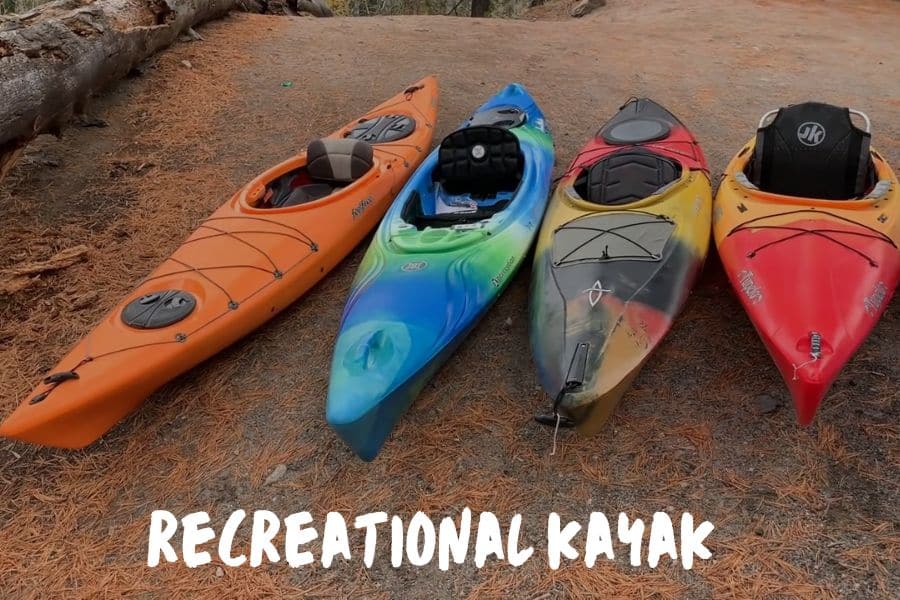
This type of kayak is typically less than 10 feet long and weighs between 40 and 50 pounds.
It’s stable and easy to maneuver, but it’s slower than other types of kayaks. Generally, it’s a great choice for beginners.
Recreational kayaks usually have a large cockpit opening, so getting in and out of them is easy and quick. But, that also means that sometimes you’re in for a wet ride, because water can get in just as easily, too.
In that case, you need to use a skirt, which we’ll talk about in a little bit.
Touring
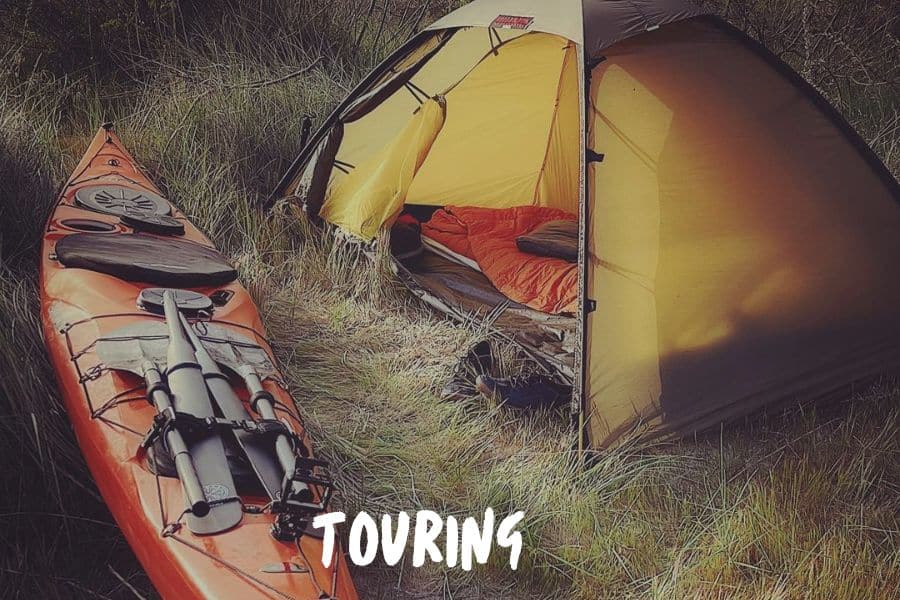
They’re longer and narrower than recreational kayaks. Thanks to that, they move through the water like a bat out of hell.
If you want to try out rough water kayaking, this is a much better choice.
Since they’re designed for longer trips, they’re comfortable and offer plenty of storage space.
Sea
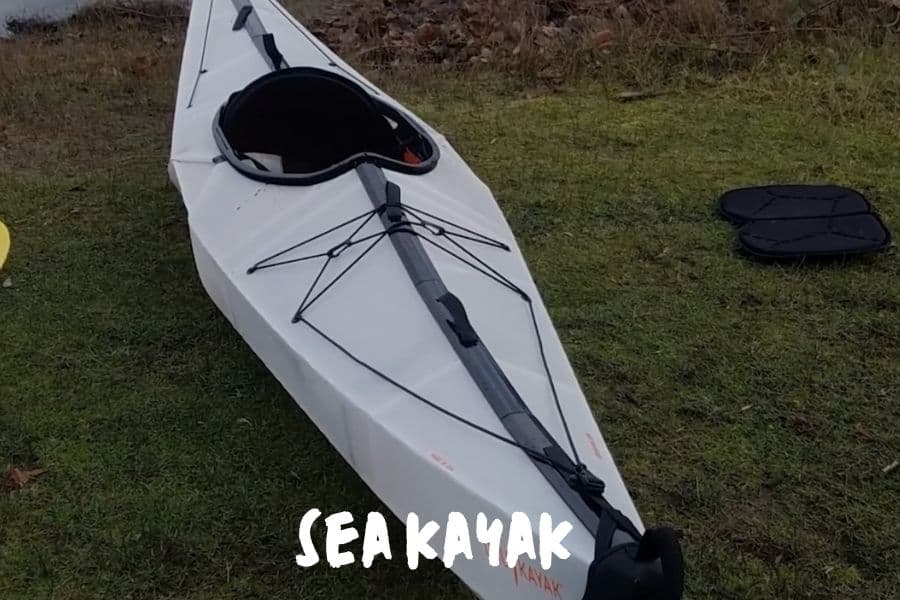
A cousin to the touring kayak, the sea kayak has a higher curve from the bow to the stern. This allows it to crest into the waves coming right at you.
It’s also slightly narrower, making it easier to maneuver. But, this also makes it less stable.
Whitewater
If you already have kayaking experience and you’re ready to hit the stream, then you need a whitewater kayak.
They’re 4 to 10 feet long, which allows them to move rapidly through rough waters.
If you want to awe your friends with your paddling skills down the river, this is the perfect choice.
But keep in mind they’re not great for steady water, nor do they offer much storage space.
Essential Gear
Obviously – other than a tent and a sleeping bag – the two most important pieces of kayak camping gear are a kayak and a paddle.
Without them, you’re not going kayaking, are you?
But, let’s see what else you need.
A Spare Paddle
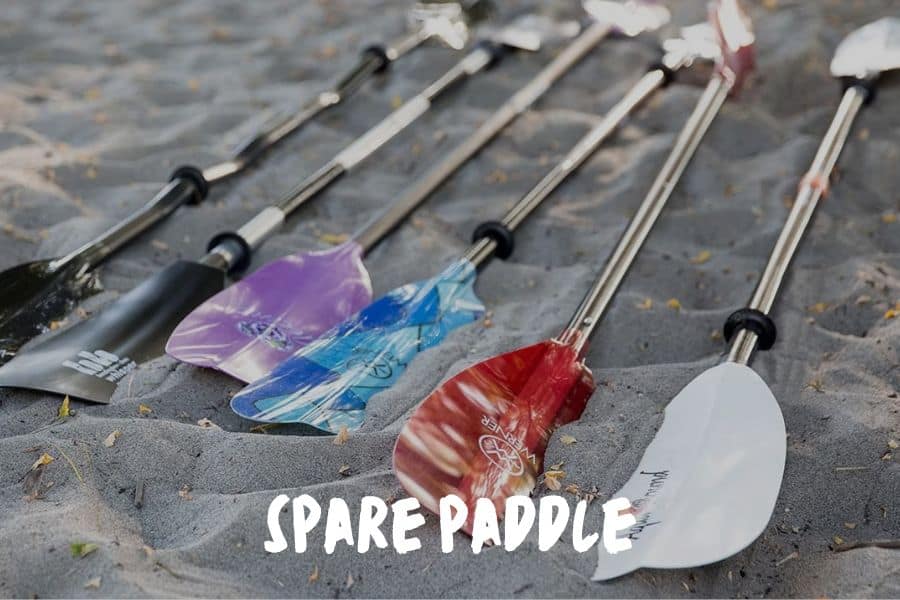
I can’t emphasize this enough – always bring a spare kayak paddle.
You never know what can happen.
You could accidentally drop it, and lose it to the tide in a glimpse of a second. And then, you’ll find yourself surrounded by water, in a kayak without any way of navigating it to the shore.
A Floating Device
The next thing you absolutely need is a personal floating device. No matter how good of a swimmer you are, you can never be too safe, especially in rough waters.
I don’t care if you’re Michael Phelps. I’d advise him to wear one, too.
A Spray Skirt
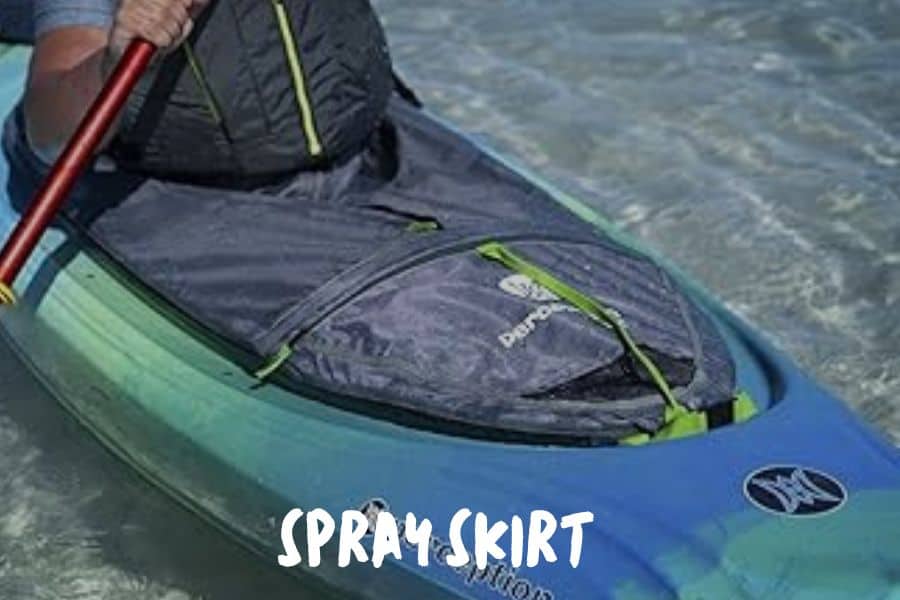
A spray skirt is a great invention that prevents water from getting inside the cockpit. It’s basically a synthetic piece of material that goes around your waist and attaches to the opening on your kayak.
The skirt is especially useful during winter, when you simply don’t want to get wet.
A Bilge Pump
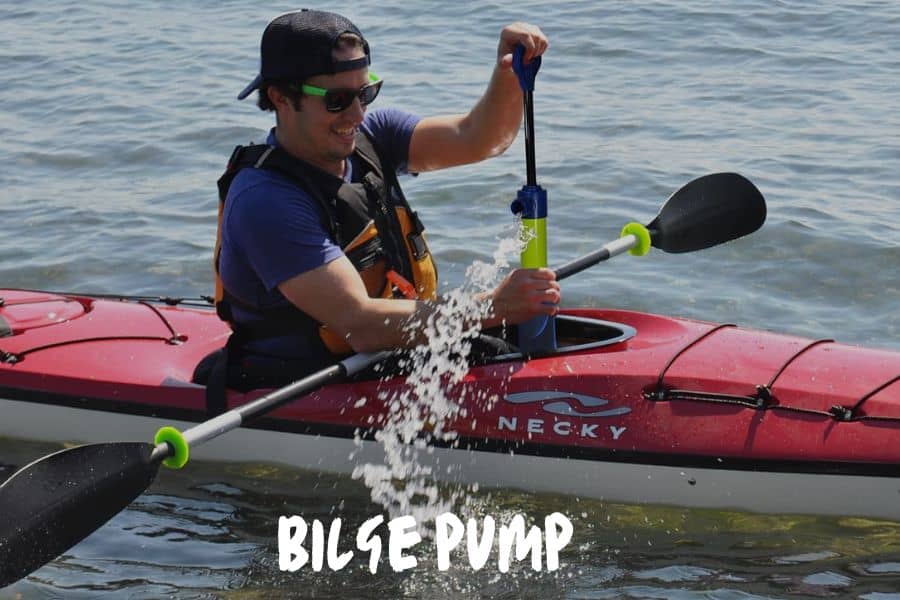
The next thing you need is a bilge pump.
In case water makes its way inside the kayak, this thing allows you to quickly get it out.
A Compass

A deck compass is also a neat accessory that allows you to find your way around.
Sure, you might have a great GSP device, but losing signal or running out of batteries is never an issue with a conventional compass.
An Emergency Repair Kit
Finally, a repair kit should always be close at hand.
Personally, I don’t like relying on probability. In fact, I don’t think the odds ever work in my favor. So, I like to be extra safe, which includes having a repair kit at my disposal.
The bare minimum every kayak repair kit should have is a waterproof sealant, duct tape, repair sheets, sandpaper, and an applicator.
Scratches will happen, and your boat is made to take on quite a beating. But dents, punctures, and gorges need to be repaired.
The good thing is, all of these can be fixed with a simple repair kit. And the best thing is – you can do it overnight at your camp and have your kayak ready in the morning for the next leg of your adventure.
More: Kayak Camping Checklist: Essential Gear (Printable & Downloadable PDF)
What to Wear
When choosing what to wear, always keep the water temperature in mind.
While it might be warm outside, water can be freezing.
If both air and water temperatures are high, dressing up is easy. You can wear a swimsuit with a light long-sleeved shirt to protect you from the sun. Just avoid cotton – it takes forever to dry out, and you don’t want to be wet when kayaking, even in warm weather.
In case the water is cold, you need a wetsuit. They’re made of synthetic fiber that keeps your body warm by trapping moisture in. Then, depending on the weather, you can add more layers of clothing.
For feet, water or paddling shoes will work great. They’re made of neoprene meaning they’re lightweight and comfortable. But above all, they’ll keep your feet dry even if you end up in the water.
Finally, don’t forget about sun protection, as you’ll be exposed to UV rays for quite some time. A hat and sunscreen are a must.
Packing Advice
When packing for overnight kayak camping, there’s one thing to keep in mind. The more you pack, the harder you’ll have to paddle. So pack only what you need.
For packing, you’re going to need dry bags, unless you want your things to get wet, that is.
But don’t get one large dry bag. Instead, get a couple of smaller ones.
Why?
Because then you can evenly distribute the weight around your kayak.
But you don’t really have to pack everything inside dry bags, just the things you shouldn’t get wet at all. This means that, for instance, canned food can be stored inside a regular bag.
The reason I say this is because dry bags aren’t cheap, so make the best use of them.
Food & Drink
Even though you’re surrounded by water, that doesn’t mean you have an unlimited water supply. Bodies of water are home to pathogens that cause a variety of diseases, like giardia and cholera.
But, you can make it work by purifying water along the way. Filters and tablets are easy ways to get clean, drinking water in the wilderness.
Kayaking is an intense physical activity, so drinking enough fluids is important. Remember, a gallon a day should be the bare minimum.
You need to eat well, too.
Foods rich in protein and fats are perfect for fueling your body, while snacking in between will keep your energy levels high.
Granola bars and nuts are my absolute favorite thing to eat while doing intense activities.
Also See: Backpacking Food Ideas for Optimal Nutrition and Taste (A Comprehensive Guide)
3 Bonus Kayak Camping Tips
Kayaking is so much fun, but there’s so much a newbie has to learn to be prepared for this kind of expedition.
Here are a few tips every beginner should know beforehand.
Go Easy
If you’re just starting out, don’t go straight into rough waters.
Choose calm water, like a lake with little or no traffic.
Plus, if there’s any wind, practice paddling with a tailwind. Going the opposite direction for a beginner can be quite frustrating until you get the hang of it.
The Art Of The Eskimo Roll
No matter how stable a kayak is, there’s always a possibility of getting flipped upside down.
This is probably the thing most kayaking newbies are worried about. But there’s no reason for that, as long as you master the art of eskimo roll.
Ideally, you should take a kayaking class and learn this from an instructor. But, that’s not to say you can’t practice it yourself after doing some research.
Pack Your Communication Devices
Water is too unpredictable.
You can never be too safe, and I don’t mean just wearing a floating device. If you find yourself stranded in a remote area with an unrepairable kayak, you need to let someone know your location.
Whistles, flares and safety lights are a few ways to attract the attention of other people close by.
What’s Next?
It doesn’t get any more adventurous than a kayaking camping trip.
You spend the day navigating through the water, and then you rest by the campfire and sleep in the wilderness.
Sure, a kayak trip requires some serious preparation, but the end result is worth it. And with the tips and advice from this article, you’re pretty much set for your paddling adventure.


